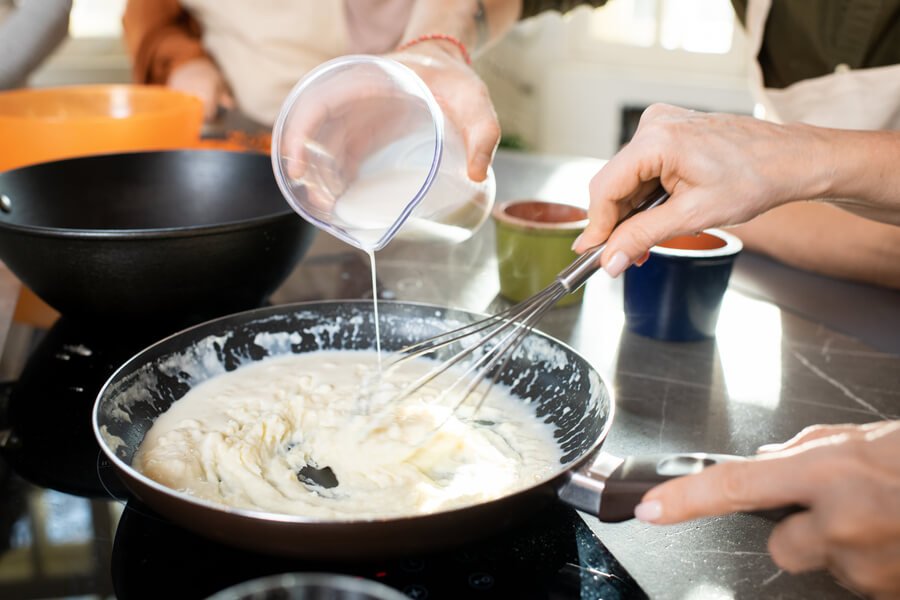Have you recently cut dairy from your life only to discover that many cooking recipes use whole milk? Are you worried about ruining your baked goods if you use almond milk instead?
Cooking with almond milk is a great alternative to using whole milk. Although you may have to make a few adjustments to the recipe, you can use almond milk in essentially any cooking or baking recipe!
If you're curious about how to cook with almond milk, how to substitute almond milk in recipes, and the differences between cooking and baking with almond milk, then you have come to the right place!
This article will give you some helpful tips when substituting and might even provide you with a few recipe ideas!
Can You Cook With Almond Milk?
Yes, you can with almond milk. If a recipe calls for any type of milk, you can use almond milk as a direct replacement in most instances.
Can Almond Milk Boil?
One popular reason that people refrain from cooking with almond milk is the misconception that it won’t boil or heat up enough. This is false.
While you may not want to bring your almond milk to a rolling boil, this is true about any milk.
Boiling milk causes it to curdle and can taint the taste of your final product. To heat almond milk safely you should only use a medium heat and stir frequently.
If you want to be even more cautious, consider using a double boiler.
This is when you place water in the bottom of a pot, place a boil with almond milk on top, and allow the rising steam from the boiling water to heat the milk.

Can You Bake With Almond Milk?
Baking is more of an exact science which means when you might have to do a little more experimenting with your almond milk substitution. When baking, you can use an equal substitution, but you will need to watch the clock and potentially shorten the baking time.
Almond milk contains a higher percentage of water than cow’s milk. When it is baked, that water evaporates quicker which speeds up the process of baking. Just take care to watch your baked goods and set the timer for a few minutes less than the recipe suggests and you shouldn’t run into any issues.
If you’ve used your almond milk in place of milk for a cookie recipe or something similar, you may have gotten slightly paler looking cookies than you're used to. Although they might taste great, you might feel there is a little something missing.
The reason behind this pale complexion is that almond milk lacks the same amount of protein as cow's milk, which inhibits the browning process when baking.

What Is The Best Type of Almond Milk For Cooking?
While we won’t get into the different brands of almond milk out there, you may be wondering if you should be using sweetened or unsweetened almond milk.
Generally, when you’re cooking with almond milk you might want to avoid the kind with added sweetener or flavors (e.g. vanilla or chocolate almond milk) as it can change the taste of your recipe.
When baking you can use the sweetened almond milk without any issues. However, if you’re trying to minimize the sugar of your baked items you again might consider using less sugar in other areas of the recipe or using unsweetened almond milk.
In most cases, we suggest cooking with plain unsweetened almond milk. They tend to have better ingredients (ideally just almonds and water) and the milder flavor makes it easier to adapt into any recipe.
Tips For Cooking With Almond Milk
Generally, if you're making a simple recipe such as mashed potatoes or mac and cheese, it's easy to replace cow’s milk with an equal amount of almond milk.
However, although you can do an equal ratio between the milks, there are other things you should consider when substituting almond milk.
Avoid Added Sugar
First, almond milk from the grocery store will usually contain added sugar, which regular cow’s milk does not. If you are substituting almond milk into a recipe that calls for additional sugar, you might want to cut down on the sugar you add to avoid it being too sweet.
Thicken It Up
And second, if you are making something that needs to thicken, such as gravy or chowder, you may need to add a thickening agent.
Almond milk is thinner than cow's milk and would benefit from some added flour or cornstarch to ensure you still get the same consistency.

Can I Substitute Cream Or Buttermilk With Almond Milk?
What if you come across a recipe that calls for cream or buttermilk? Not to worry! Almond milk is still a great substitute.
In order to make cream, you’ll have to bring another nut staple into play: the cashew. When cashews are soaked and blended with almond milk, the result is a rich cream.
Unfortunately, almond milk by itself will not whip up into a perfect cream, but with a little ingenuity it is still possible to make a replacement.
As for buttermilk, you simply need to combine your almond milk with lemon juice. One cup of almond milk and a tablespoon of lemon juice will produce a milk with the similar flavor profile and consistency of buttermilk.
This concoction should produce the same effects in both cooking and baking.
If you don't have lemon juice, you can also use vinegar in a pinch and get the same result.
What Are Some Easy Almond Milk Substitutions?
Now that you’ve read through this article you may find yourself asking where to start?
The easiest almond milk substitutions would be through cooking, or simple baking recipes such as pancakes or waffles.
When cooking mashed potatoes, mac and cheese, soup, sauces, or gravies, try replacing your cow’s milk with almond milk and see how easy it is.
Almond milk doesn’t contain a strong almond taste and you may be surprised at how similar it tastes.
Once you get a knack for it you can try it with more and more complex recipes.
Related: How to Make Almond Milk Taste Better
FAQ
Can You Cook With Silk Almond Milk?
Silk is just one of the many brands of almond milk out there. You can absolutely cook with Silk almond milk following the guidelines in this article.
You can even use some of Silk’s almond milk and other nut milk combo beverages for your substitutions without any adverse effects.
If you're going to use Silk almond milk, opt for the plain unsweetened version to avoid added sugar and flavors. However, we typically recommend sticking to brands with simpler ingredients than Silk.
Can You Cook With Vanilla Almond Milk?
Cooking with vanilla almond milk is a little less common than using plain almond milk due to its distinct flavor.
While it may not be the best choice for savory recipes, if you’re making a cake or pudding, feel free to use the vanilla almond milk for added flavor!
Conclusion - Move Aside Cow’s Milk!
No matter the reason you’ve switched to almond milk (or any other nut-based milk), whether due to lactose intolerance, a vegan diet, or environmental concerns, you can rest easy knowing that you don’t have to give up any of your favorite recipes.
